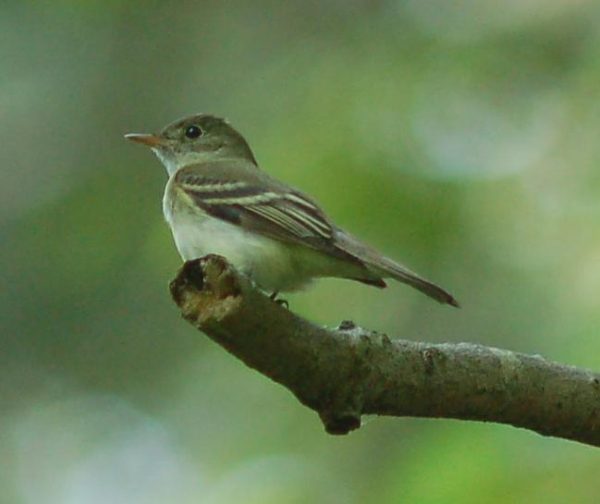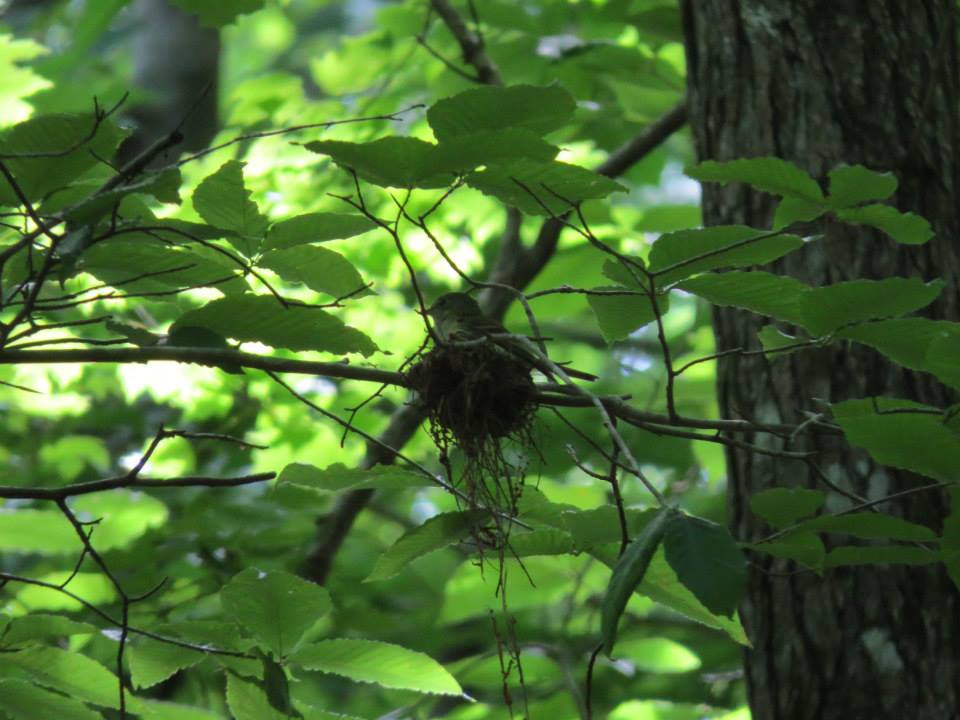Flycatchers – architects of nature

During one hike over my summer internship with The Land Trust for Central NC, we were able to spot a small and sweet little bird. Here, in the Uwharries, if you hear birds calling “peetsah” or making sounds that are akin to funny laughter, they are most likely flycatchers. We have Great Crested and Acadian flycatchers here. They are both insect-eating birds of the tyrant flycatcher family.
The tyrant flycatchers are a clade of passerine birds, which are considered the largest family of birds on Earth, with more than 400 species. This large family occurs throughout North and South America and the members vary greatly in the shape, patterns, size and colors.
The adult Acadian flycatchers have olive upper parts, darker on the wings and tail, with whitish under parts. They have a white-eye ring, white wing bars and a wide bill. The breast is washed with olive. The upper part of the bill is dark; the lower part is yellowish. They breed in deciduous forests, often near water. They are fascinating little birds that are excellent fliers – extremely maneuverable and able to hover and even fly backward. They have been observed bathing not by standing in water, but rather by diving into water from above, hitting the water with their chest, and then returning to a perch to preen and shake.
The Great Crested flycatcher is a large family member of tyrant flycatcher family. The Great Crested Flycatcher does not display sexual dimorphism, therefore the female and male are nearly identical. All adults have rich reddish-brown accents and a lemon-yellow belly. They have a long rusty brown tail and a bushy crest. Their throat and breast are grey. Like many flycatchers they have a powerful build with broad shoulders and a large head. Great Crested Flycatchers are sit-and-wait predators, striking from high perches (usually near the tops of trees) after large insects, returning to the same or a nearby perch.
Flycatchers have some unique behavioral characteristics, as well. Great Crested flycatchers weave shed snakeskin into their nest. Especially in Florida, nearly every nest contains snakeskin. They also seem to look for flimsy and crinkly materials like onion skins, cellophane or plastic wrappers. Flycatchers seem to be great architects of nature.
About Acadian flycatchers, they are known as a common host to the brood-parasitic Brown-headed cowbird. Brown-headed cowbirds will lay their eggs in the nest of other birds, and as the baby cowbirds are larger they can outcompete the bird’s own young for food. Nests are parasitized more in small woodlots than in large tracts of intact forest. However, Acadian flycatchers don’t seem to be willing to host other birds and studies have shown that only 16% of cowbird young in Acadian flycatcher nests fledge successfully. Sometimes birds will leave an already established nest and create a new nest to avoid raising cowbird fledglings.

All these interesting facts and stories have encouraged me to take up bird watching as a hobby myself. Now I can try to tell the differences between different birds as I spot them out to my friends. What I experienced and learned while working with ornithologist John Gerwin over the summer confirms to me one thing: I love nature! I hope more and more people will get out and enjoy and experience nature, which is full of surprises. When you take the time to walk or hike outdoors you never know what you may find.
Zoe Pu wrote this article while interning for the LandTrust for Central North Carolina in 2014. At the time she was a student at Duke University.
Zoe Pu